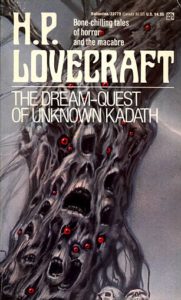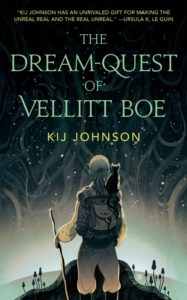Tor’s novella series was started in 2015, with the aim of promoting this shorter medium. The line includes both established authors and those just making their debut, and has included a number of authors from diverse backgrounds. The resulting line is full of interesting and different stories from authors both familiar and new. This column will take in highlights from the line.
She hadn’t loved Randolph Carter. He had been a man like many, so wrapped and rapt in his own story that there was no room for the world around him except as it served his own tale: the black men of Parg and Kled and Sona Nyl, the gold men of Thorabon and Ophir and Rinar; and all the women invisible everywhere, except when they brought him drinks or sold him food – all walk-on parts in the play that was Randolph Carter, or even wallpaper.
 H. P. Lovecraft’s Dreamlands stories, written between 198 and 1932 but culminating in The Dream-Quest of Unknown Kadath (1926), are key texts of early fantasy. Describing a fantastical world that can be accessed only through dreams, these stories contain some of Lovecraft’s most lyrical writing. This is perhaps not surprising, given Lovecraft’s view of dreams as a blessed respite from the cold horrors of reality. Lovecraft’s cosmic pessimism and his signature inventive monstrosities are contrasted with scenes of childlike wonder and wistful nostalgia.
H. P. Lovecraft’s Dreamlands stories, written between 198 and 1932 but culminating in The Dream-Quest of Unknown Kadath (1926), are key texts of early fantasy. Describing a fantastical world that can be accessed only through dreams, these stories contain some of Lovecraft’s most lyrical writing. This is perhaps not surprising, given Lovecraft’s view of dreams as a blessed respite from the cold horrors of reality. Lovecraft’s cosmic pessimism and his signature inventive monstrosities are contrasted with scenes of childlike wonder and wistful nostalgia.
Unfortunately the stories are frequently marred by Lovecraft’s racist attitudes, with characters from other cultures reduced to grotesque caricatures. But the stories also betray something of Lovecraft’s attitudes towards women. In his travels across the Dreamlands, Randolph Carter meets people from the varied realms, toad-like moon beasts and talking cats, ghouls and gods, yet he barely encounters any female characters whatsoever.
 In The Dream-Quest of Vellit Boe (2016), Kij Johnson offers both a tribute to and a critique of the Dreamlands stories. Cleverly mirroring the structure of The Dream-Quest of Unknown Kadath, Johnson’s novella is a delirious joyride through the Dreamlands, as Professor Vellit Boe from Ulthar Woman’s College tracks down one of her students who has run away with a man from the waking world. Packed with vivid Lovecraftian imagery and numerous references both obvious and subtle to his work, the novella is a tribute to the imagination of Lovecraft and the tradition of the Weird tale. However it is also a powerfully feminist critique of Lovecraft’s worldview, interrogating the key assumptions that the Dreamlands are built on. The flipped perspective of a protagonist who is both female and a native Dreamlander allows Johnson to examine how Lovecraft’s ingrained prejudices about women and people from different cultures shaped the fantasy world he created.
In The Dream-Quest of Vellit Boe (2016), Kij Johnson offers both a tribute to and a critique of the Dreamlands stories. Cleverly mirroring the structure of The Dream-Quest of Unknown Kadath, Johnson’s novella is a delirious joyride through the Dreamlands, as Professor Vellit Boe from Ulthar Woman’s College tracks down one of her students who has run away with a man from the waking world. Packed with vivid Lovecraftian imagery and numerous references both obvious and subtle to his work, the novella is a tribute to the imagination of Lovecraft and the tradition of the Weird tale. However it is also a powerfully feminist critique of Lovecraft’s worldview, interrogating the key assumptions that the Dreamlands are built on. The flipped perspective of a protagonist who is both female and a native Dreamlander allows Johnson to examine how Lovecraft’s ingrained prejudices about women and people from different cultures shaped the fantasy world he created.
The Dream-Quest of Unknown Kadath follows Randolph Carter, Lovecraft’s fictional alter ego, on a quest to find the hidden dwelling of the gods in the city of Kadath so that Carter can petition them to reveal the location of the fabulous city of his dreams. The Dream-Quest of Vellit Boe is not a mission of conquest to gain something never had, but a mission to rescue both Claire Jurat, Boe’s missing student, and Ulthar itself. Claire is the granddaughter of a god, and, as is borne out in almost all the Dreamlands stories, Lovecraft’s gods are petty and vengeful, and Claire’s grandfather would certainly destroy the city and all its inhabitants if he discovers she has disappeared while under their care.
Priorities are not the only difference in perspective between Randolph Carter and Vellit Boe. Carter sees the Dreamlands as an escape, a fantastical realm separate from his waking existence, and for all his mastery as a dreamer he is only ever there as a tourist. Boe was born in the Dreamlands and has lived there her whole life. For all its magic and wonder, she sees it as home. The mystical ancient cities, bustling sea ports and enchanted forests are part of her heritage and her life, the people and creatures of the Dreamlands her friends, family and colleagues. Carter can escape the dangers of the Dreamlands by simply waking up; to do that for Boe means leaving behind everything and everyone she ever knew.
Of course, Boe and Carter’s perspectives also differ because of their genders. Johnson’s exploration of Lovecraft’s attitudes towards women is pointed and powerful. Having Vellit Boe meet Randolph Carter in the story allows Johnson to directly confront Lovecraft himself. Randolph Carter, as Lovecraft’s fictional alter ego, was more than just another character to him; Lovecraft would essentially use him in stories as a self-insert, making stories featuring him a kind of wish fulfilment. Having Boe and Carter be former lovers and old travelling buddies symbolises Johnson’s love and respect for Lovecraft’s fiction and its transportive powers. However, Carter’s self-involved solipsism and sense of entitlement drove them apart, and an older and wiser Boe can’t help seeing the flaws in the man.
Despite Boe having lived there her whole life, the lack of women in Dreamland bothers her, as does the fact that all the visitors from the waking world appear to be men. Boe knows Carter’s explanation that, “Women don’t dream large dreams,” is a load of nonsense, this is a narrative choice of Lovecraft’s based on his own preconceptions. Similarly she finds herself repelled by Carter’s patronising and entitled view of the people of colour he encounters in the Dreamlands, a reflection of Lovecraft’s racism.
On a deeper level, Lovecraft’s capricious gods, and hence Lovecraft himself as the creator of the Dreamlands and engineer of the downfall of all its lost civilisations, are equated with the patriarchy. The gods of the Dreamlands have created this system of oppression and tyranny by which they respond to perceived slights with violence and destruction; their power is maintained by fear. The detritus of ruined civilisations that litter the Dreamlands could be our cities destroyed by nuclear war or climate change, the spoils of humanity’s hubris and lack of empathy. The civilisations of the Dreamlands live under fear of annihilation. Claire Jurat experiences our godless universe as a respite from all this horror; when she returns to the Dreamlands and claims her goddesshood it is to destroy the gods themselves so that people no longer have to live in terror.
Within all the fantasy elements, the novella also manages to explore Vellit Boe’s life with a quiet realism. Boe’s experiences growing up as a woman in a patriarchal society is well observed, and the novel contrasts the restlessness of her travelling days in her youth with her life as a professor at the College. Always fiercely independent, Boe has gone from carving out her own path to helping nurture and support the next generation of ambitious and intelligent young women who refuse to be pigeonholed by the restrictive society they find themselves in. Boe’s quest finds her reflecting on her advancing years and the cost they have brought with them.
Johnson wisely avoids imitating Lovecraft’s particular style with its archaism and adjectival overload. However using her own voice she manages to channel the Dunsany-esque sense of wonder and the oddly compelling rhythmic build-up of hallucinogenic imagery that characterise Lovecraft’s Dreamlands stories. For all its weirdness, she manages to also make the Dreamlands parse as a real, lived-in place, giving the novella a granularity and attention to the mundane that was never present in the originals. This is quite the balancing act. Impressively, when Vellit Boe crosses into our world towards the end, the descriptions change tenor, rendering our recognisable world strange and uncanny through the eyes of someone to whom it is all thoroughly alien. Thus the Dreamlands are given the air of reality, while our world is given the appearance and feel of a dream.
However for all its subversions and reinventions, The Dream-Quest of Vellit Boe brings a real affection for its source material. Almost every location from Unknown Kadath is revisited here, from Ulthar itself, where no man may kill a cat, to magnificent Celephais, to the forest of the zoogs and the underground caves and caverns. Night-ghasts, ghouls and gugs all make an appearance. This affection for the original stories makes Johnson’s astute criticisms land all the harder.


This novella sounds interesting! I’ll keep my eye out for it.